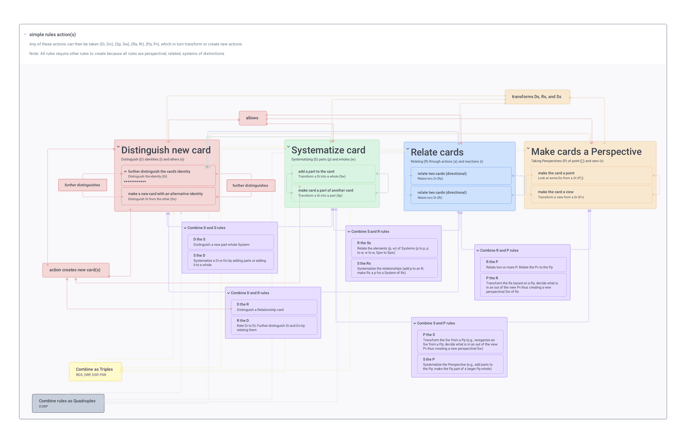DSRP Theory can be "methodologized" but what does it look like?
DSRP Theory provides the basis for a systems research method that structures systemic analysis of any phenomena and can be used by researchers to approach difficult problems. The DSRP Theory is not the same as the DSRP Method. The Method is a derivation of the theory that reduces it to step-wise, although nonlinear, process for analyzing and performing structural analysis. Methodologically, one adheres to the simple rule set, starting with an initial condition (pink), and running through the primary, secondary, tertiary, and quaternary possibilities until a stopping rule is reached. Stopping rules are determined by perspectives (which are part of the analysis).
DSRP is dynamic, rather than linear and step-wise. You can get a "flavor" for this dynamism in this short film that shows how DSRP is operating "simultaneously:"
The following schematic shows the DSRP Theory in terms of its methodological approach. The key below details the meaning of the colors in terms of stepwise* processes. *Note that DSRP is not a stepwise process but occurs simultaneously and in different orders.

A dynamic Map of this method can be found below (you can duplicate it to make your own editable copy)
The DSRP Mapping Method is the basis for an Agent Based Approach (ABA). See:
Mulyono, Y., Sukhbaatar, U., Cabrera, L. and Cabrera, D. (2021). “Hard” and “Soft” Methods in Complex Adaptive Systems (CAS): Agent Based Modeling (ABM) and the Agent Based Approach (ABA).. In, Routledge Handbook of Systems Thinking, (Eds) Cabrera, D., Cabrera, L. and Midgley, G. Routledge. London, UK.
If you're a researcher and would like to use DSRP Methodology feel free to contact us for more info.
